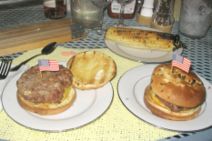Hamburger
A hamburger (or hamburg or burger) is a sandwich made with a bun containing a patty of ground, cooked meat that is almost always beef, usually served with condiments such as relish, mustard, or ketchup. The bun is usually but not always toasted or otherwise warmed.
Most authorities consider that the word "hamburger" is derived from the German city of Hamburg, which once enjoyed prosperous commerce with the Baltic Provinces in Russia, where shredded raw meat (we now know it as steak tartare) was popular. [1] Around 1900, a popular meal in the United States was "Salisbury steak," cooked, ground steak, which was promoted by a food faddist named Dr. J. H. Salisbury as a cure for innumerable ailments. At some point in the late 19th or early 20th century hamburgers as we know them, cooked patties within a roll, made their first appearance in the United States, although exactly where and when is still debated.
Generally considered to be an informal meal or a convenience food, its meat can be grilled, fried, broiled, microwaved, or steamed. One of its most popular variations, a hamburger served with melted cheese on top, is called a cheeseburger.
Many cultures over the centuries have cooked finely chopped or ground meats in shapes such as meatballs, patties, or steaks, often flavored with other ingredients. The Larousse Gastronomique, for instance, gives a half-dozen Hungarian, German, and Austrian recipes for what it calls Keftedes, all translated as variations on "hamburgers". [2]
Standardized fast food
Tens of thousands of diners and restaurants in the U.S. serve their own version of the hamburger. Standardization was invented by Walter Anderson, who in 1921 opened the first of a nationwide chain of White Castle fast food outlets. Anderson trained his staff to cook and serve in exactly the same way, cooking dozens of pre-weighed, pre-shaped burgers at once on a dedicated griddle, and serving them on specially designed buns. Ray Kroc (1902-1984) in 1954 bought a California "drive-in burger bar" from Richard and Maurice McDonald. Kroc standardized his product, so that today the McDonald hamburger has meat that weighs 1.6 ounces (45 grams) and measures 3 and 5/8 inches (9.2cm) across; and is garnished with a quarter of an ounce of chopped onion, a teaspoon of mustard, a tablespoon of ketchup and a pickle slice one inch in diameter. The Big Mac is likewise standardized with two patties and a sauce. Customers have limited choices, and the local franchiser, who spent millions to buy the outlet, has little control over the menu, purchasing supplies from the corporation, and paying it a royalty fee as a percent of sales.
In the 1960s the McDonald’s Corporation turned the burger into the Model T of fast food. The hamburger played an important role in America’s transformation into a mobile, suburban culture, and in the 21st century, despite strong competition from pizza and tacos, it remains America’s favorite sandwich. But Americans have mixed feelings about it: is it a robust, succulent spheroid of fresh ground beef, the birthright of red-blooded citizens? or is it a styrofoam-shrouded Big Mac, mass-produced to industrial specifications and served by wage slaves to an obese, brainwashed population? Is it cooking or commodity? An icon of freedom or the quintessence of conformity?[3]
Along with Coca-Cola, the hamburger was once disdainfully regarded by many non-Americans as the epitome of low cultural taste. With the advent of mass marketing from imitators of McDonald's such as Burger King, however, hamburgers have now spread around the world and, with variations, are consumed in every culture. Indeed the Economist magazine uses the price of a Big Mac to compare the price levels of different economies because it is the single most nearly standardized product in most countries around the globe.
Bibliography
- Gross, Daniel. "Ray Kroc, McDonald's, and the Fast Food Industry," in Forbes Greatest Business Stories of All Time (1999) pp 177-92 online version
- Kroc, Ray. Grinding It Out: The Making Of McDonald's (1992) excerpt and text search
- Love, John F. McDonald's: Behind The Arches (1995) excerpt and text search
- Ozersky, Josh. The Hamburger: A History (Yale University Press: 2008), 160pp ISBN: 9780300117585
